
Wednesday, July 29, 2009
Thursday, July 23, 2009
Woodpecker's effect on trees
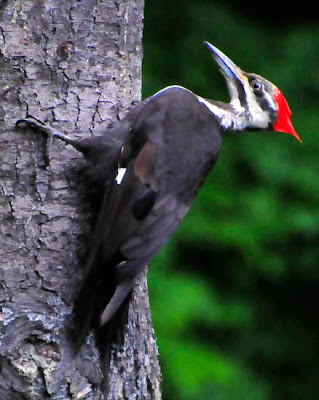

There are two trees in the front yard that have been attracting woodpeckers. One is a crab apple tree on which I have been hanging my feeders. The trunk of this tree has suffered extensive pecking damage. I think the hairies, downies, and to a lesser extent the redbellies, are problably responsible for the death of one of its major branches.


The second one is the mountain ash that I had planted in the middle of the front lawn when I first moved into the house 20 odd years ago. I thought the red berries would attract birds, but the tree, hemmed in by larger trees, never really thrived, growning tall and spindly instead. Many of the upper branches have died. I am sure the yellow-bellied sapsuckers that seemed to be particulary attracted to that tree are largely responsible. They damage the tree trunk by drilling round well holes into it that look like pockmarks.


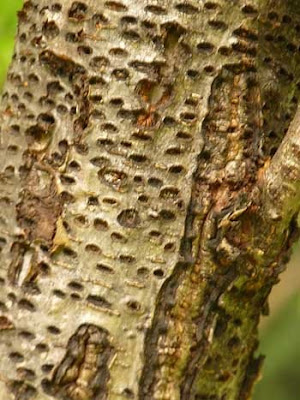
Eventually we are probably doing to lose the trees, but in the meantime they provide sustenance to the woodpeckers.
It's been very busy around the feeders: beside the woodpeckers, a family of rose-breasted grosbeaks with at least four by now almost fully grown fledglings, grackles, northern cardinals, goldfinches, red-winged blackbirds, mourning doves, blue jays, various sparrows, an immature brown thrasher, titmice and white-breasted nuthatches. There are a couple of crow families with youngsters in the large trees surrounding our property, and even an occasional raven. There must be a raven nest somewhere in the neighborhood. I hear their deep croaks when they fly over but am always too late for a photo.
Tuesday, July 21, 2009
Herrick's Cove


On my futuristic wishlist: a handheld gadget that could pinpoint the exact location of a sound. It would make finding singing birds in the summer so much easier! There is actually patent on such a device, very complicated by the sound of it, and I don't think it has been fabricated yet. Also it would be really really expensive...
Friday, July 17, 2009
Red-tailed hawk being mobbed by two small birds
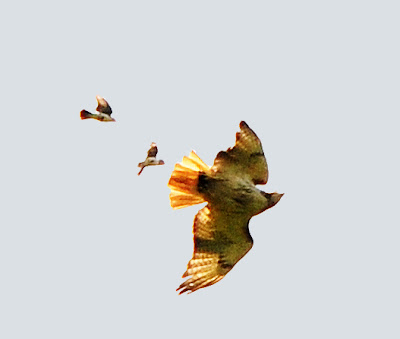

 I was fooling around with my camera in my backyard this morning trying out some different settings, when I heard a sharp hoarse cry in the sky. Looking up I saw a red-tailed hawk being harrassed by two small birds. I took a few pictures until the trio disappeared. In the third photo it looks as if the smaller bird is right above the hawk. I am not sure what those smaller birds were; someone suggested great crested flycatcher and another eastern kingbird; they look like two different species. It's probably going to be unresolved - the resolution is just not good enough.
I was fooling around with my camera in my backyard this morning trying out some different settings, when I heard a sharp hoarse cry in the sky. Looking up I saw a red-tailed hawk being harrassed by two small birds. I took a few pictures until the trio disappeared. In the third photo it looks as if the smaller bird is right above the hawk. I am not sure what those smaller birds were; someone suggested great crested flycatcher and another eastern kingbird; they look like two different species. It's probably going to be unresolved - the resolution is just not good enough.
Thursday, July 16, 2009
Indigo Bunting, Great Egret and Belted Kingfisher
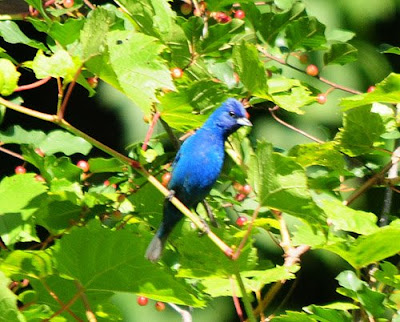
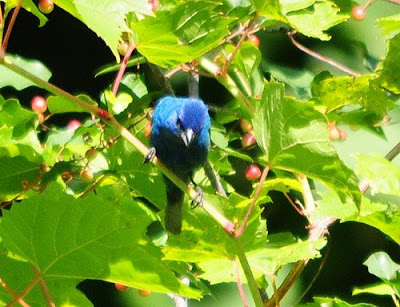
This morning I went back hoping for better pictures, but no such luck. I did however see a great egret on the sandbank in the West River.
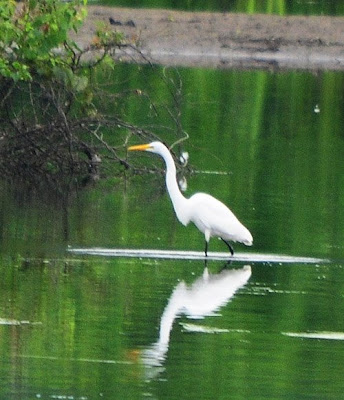

Yesterday in Keene by the pond behind the Target store I saw a belted kingfisher hovering over the water, then plunging down to grab a fish. Here are some photos of the bird hovering - the drop into the water was too fast for my camera.

Here is the bird in repose. I think it was waiting for me to go away, which I did.

Wednesday, July 8, 2009
Hinsdale Bluffs Bank Swallow Colony and Orchard Oriole
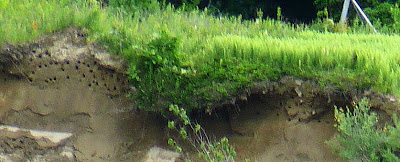
I also saw an orchard oriole, I think the second one in my life - the first one was probably 15 years ago. I was just carrying a small point-and-shoot camera and tried to get a photo, but it was of course totally inadequate as you can see below.
 When I first saw the bird among the leaves in a bush I thought, by the size, that it was an American Redstart, although the red didn't appear to be quite right. Only after it flew off and settled on a bush further away did I realize my mistake. I am going to go up there again with my big camera and hope that I will have another chance.
When I first saw the bird among the leaves in a bush I thought, by the size, that it was an American Redstart, although the red didn't appear to be quite right. Only after it flew off and settled on a bush further away did I realize my mistake. I am going to go up there again with my big camera and hope that I will have another chance.
Tuesday, July 7, 2009
Pelagic Trip to Jeffrey's Ledge
Double-crested cormorants were perched all along the breakwater as we were leaving the harbor. Here is an adult with a juvenile.

Soon after leaving the harbor we encountered our first Northern Gannets. They were all juvenile - this year's fledglings. Later on we also saw a couple of adults.

We saw rafts of Wilson's Storm-Petrels throughout our trip. They took off as soon as our boat approached. They are small graceful birds, often appearing to be running or dancing on the water. They are spending their lives out on the water and according to David Weaver they are one of the most numerous birds on the globe.


 These birds are so small that they were difficult to photograph but the intricate mirror images on the calm sea were absolutely beautiful!
These birds are so small that they were difficult to photograph but the intricate mirror images on the calm sea were absolutely beautiful!
Lastly we saw numerous Greater and Sooty Shearwaters. There were also some Cory's but I did not see them. I also missed getting photos of the single Parasitic Jaeger and the Roseate Tern.

This Greater Shearwater has a drop of a concentrated salt solution hanging off it's beak - that's how the bird excretes the salt it takes in with the seawater. According the Christopher W. Leahy in The Birdwatcher's Companion to North American Bird Life the salt is concentrated in salt glands located in the bird's skull with a duct to the nostrils. From there the salt solution dribbles down the beak to the tip where it hangs until it is shaken off. 
Sooty Shearwaters are about the same size as the GS. The name is self-explanatory.


We also a saw humpback whales, minke whales and fin whales. The humpbacks put on a great show with two females, Clamp and Valley, creating a bubble net and appearing suddenly next to each other out of the deep, mouth agape, to gulp the fish.
On arriving back at the dock we received the message that Rte 1 out of Newburyport was jammed up for miles due to a traffic accident on I 95 earlier in the morning. Instead of joining the jam, I drove out to the Parker River Wildlife Refuge. I stopped at Lot # 1 to see the Purple Martins. What a different scene from May a year ago when I came here last! There were only a few birds, not the boisterous crowd of last year. According to Sue McGrath the birds were starving due to the rain and cold weather. Many fleglings and females had perished of the cold and starvation. Here is her report. I drove down to Sandy Point but did not see anything of note and found that by 6 pm the route home was clear.
This morning David Weaver's trip report arrived which gives a vivid account of our trip and a list and number of the birds encountered. Thanks to David Weaver and David Larson and to all who made this trip possible.
Grey Partridge (Perdix perdix) identified by sound
On my recent trip to Northern Germany I was walking on a path bordering a field out in the country, a large field with short stubby grass which had recently been cut. As I was concentrating on listening to the melodius fluting song of a Common Blackbird (turdus merula) in a nearby bush I became aware of another sound, a series of eery low pitched scratchy sounds just beyond the edge of the field, it seemed, but the exact distance was hard to pin-point In the increasing darkness I gradually made out the dark silhouette of a game bird crouching near a clump of grass in the middle distance, from which the sounds seemed to be coming. I recorded a section and identified it as a grey partridge (link to audio file)
Spectrogram & waveform using Raven Lite 1.0:

Although I grew up in Germany in the 50's and early 60's I had never heard this sound before nor had I seen grey partridges which were supposed to have been quite abundant, although less so today because of intensive cultivation and loss of habitat. It was introduced to North America where it is also known as "Hungarian Partridge". It was extensive hunted in the UK and is currently on the Red List there.
Sunday, July 5, 2009
Photography
The weather is going to be nice, I think, and I hope to get lots of pictures to post on the site here.
P.S. 7/7/09 The idea with the blackened toilet paper tube turned out to be poppycock. I stood in the shade for most of the trip and all I had to do was shade the screen with my hand to see the histogram.
Thursday, July 2, 2009
Henslow's Sparrow

Another birder with a scope was kind enough to let me take a look. What a beautiful little bird! I was amazed at the brightness and clarity of the image. I'd been holding off on getting a scope but this made me change my mind, although this particular one, a Swarovski, would out of my price range right now. I did manage to get an 11 sec recording of the song, not great quality but good enough, I think, to give an impression. The spectrogram helps in visualizing the song.

Mark Fairbrother posted the first report on June 27. It seems a miracle that he discovered him, particularly since the song is not very loud. There have been very few recorded observations and, although historically a breeder in Massachusetts, he is now listed as an endangered species in the state. Unfortunately the chances of him finding a mate are incalculably small.



